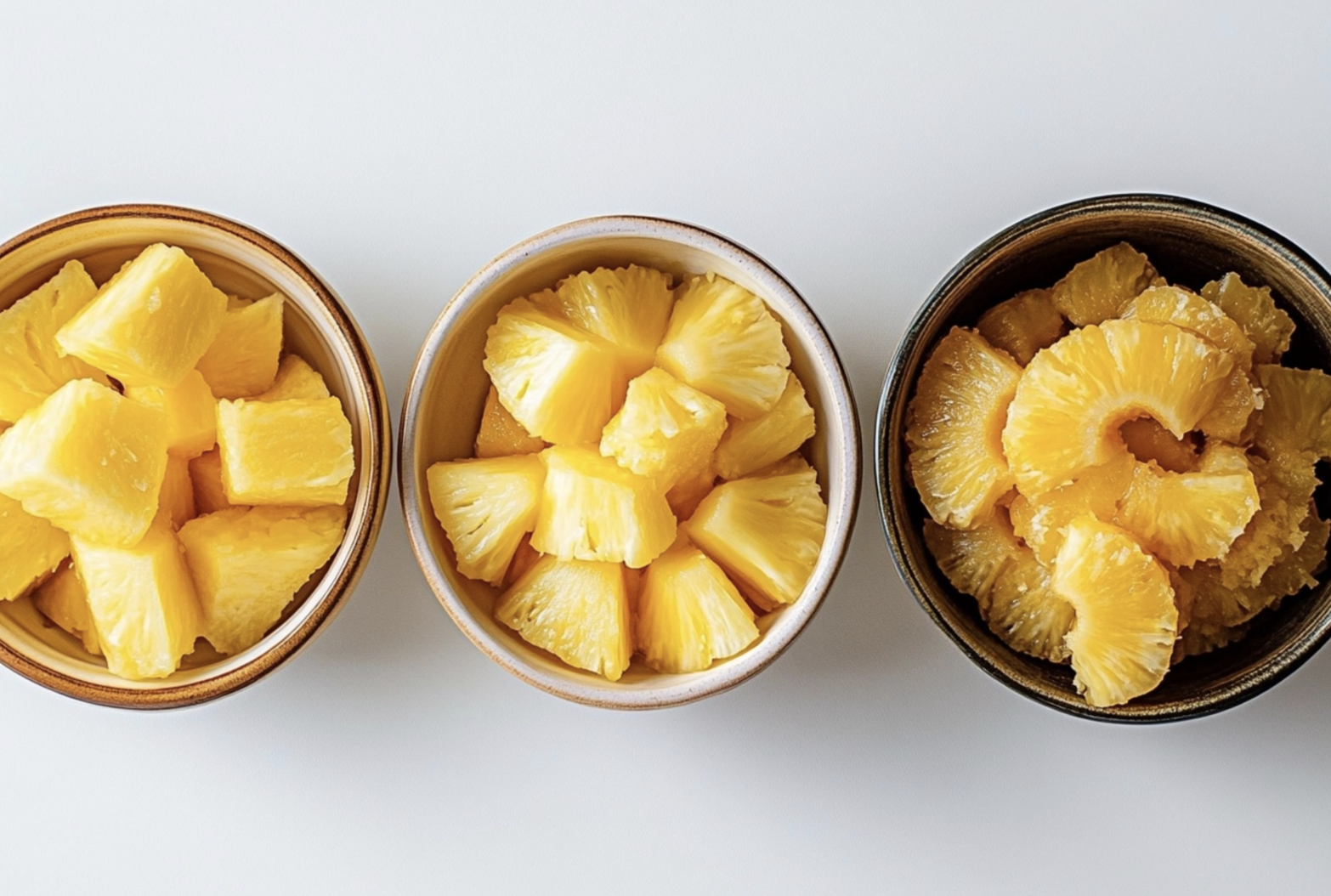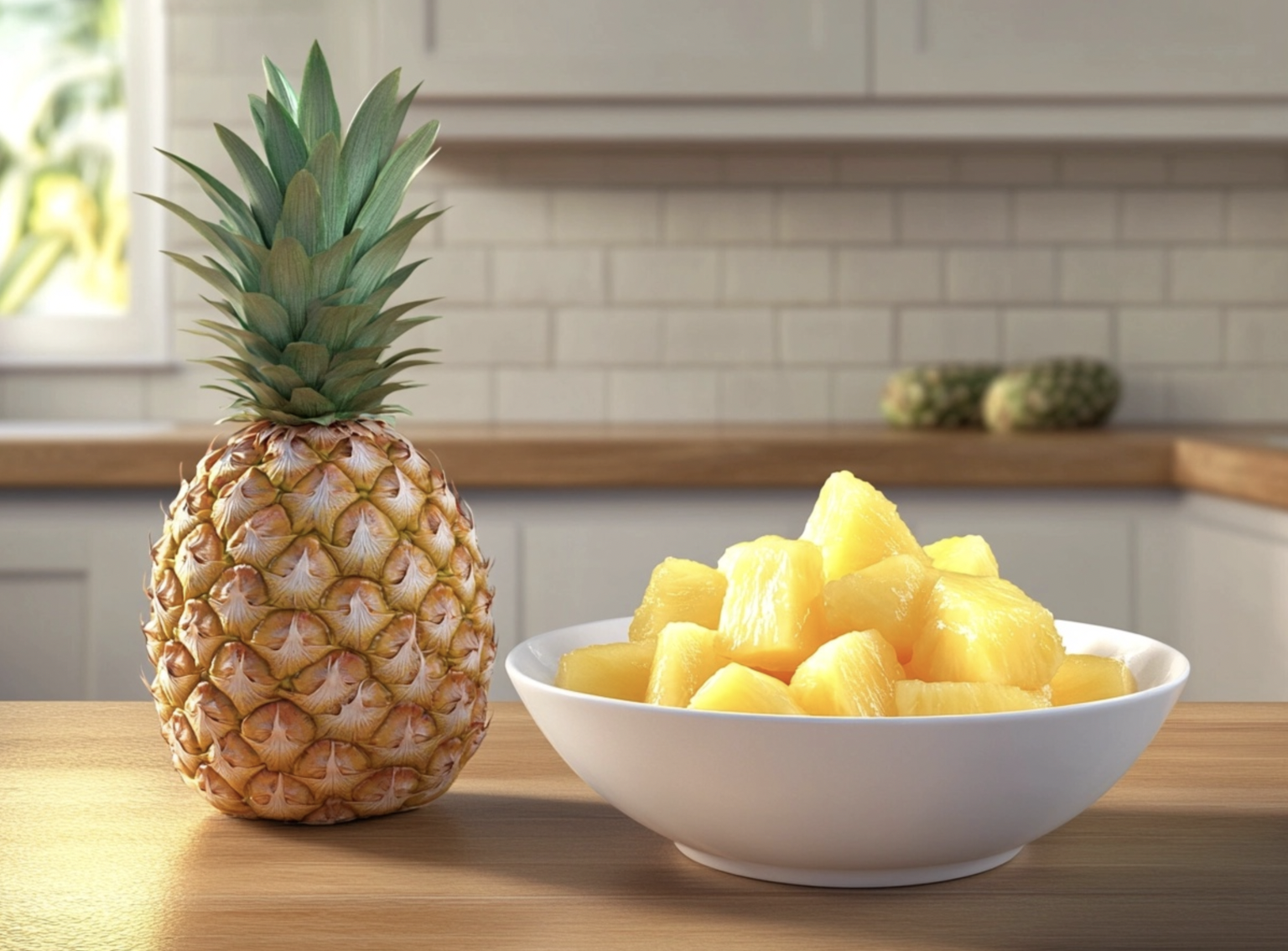Table of Contents
Pineapple casserole is one of those timeless dishes that combines sweet and savory flavors in a way that surprises and delights. As someone who grew up enjoying this comforting dish at family gatherings, I’ve experimented with both canned and fresh pineapple over the years. One question I often hear is: “Can I use canned pineapple instead of fresh pineapple in my casserole?”
The short answer is yes, but there are important factors to consider. In this article, we’ll explore the differences between canned and fresh pineapple, how each affects your pineapple casserole, and some personal tips for making the perfect dish every time.
Canned vs. Fresh Pineapple – Key Differences
Texture and Flavor
Canned pineapple is softer and sweeter because it’s packed in juice or syrup, while fresh pineapple offers a firmer texture and a natural tangy flavor. In a pineapple casserole, canned pineapple blends seamlessly into the dish and adds a consistent sweetness. Fresh pineapple, on the other hand, has a more vibrant flavor that can add an extra layer of complexity.
Convenience
One of the biggest advantages of canned pineapple is convenience. No peeling, coring, or chopping is required. When I’m in a rush, I love how canned pineapple saves me time without sacrificing the overall quality of the dish. Fresh pineapple requires more prep, but if you’re looking for a farm-to-table feel, it might be worth the effort.
Storage and Availability
Canned pineapple is available year-round and has a long shelf life, making it a reliable pantry staple. Fresh pineapple is seasonal and needs to be used quickly once cut. If you’re planning a pineapple casserole out of season, canned is the go-to option.
Canned Pineapple in Pineapple Casserole

Pineapple casserole is a classic Southern dish that combines the sweetness of pineapple with the richness of cheese and the crunch of a breadcrumb topping. It’s a perfect example of a recipe where canned pineapple shines.
Why Canned Pineapple Works Well
Canned pineapple is an excellent choice for pineapple casserole because of its pre-cut convenience and consistent sweetness. The soft texture blends seamlessly with other casserole ingredients, while the sweetness enhances the savory and cheesy elements. Additionally, canned pineapple’s shelf-stable nature makes it a practical option for last-minute meal planning.
Enhancing Flavor with Canned Pineapple
When using canned pineapple in a casserole, you can balance the sweetness by choosing unsweetened pineapple or draining excess juice. To elevate the flavor, consider adding a pinch of cinnamon or nutmeg, which complements the tropical notes while creating a more complex taste profile.
Fresh Pineapple in Casseroles
While canned pineapple is a convenient choice, fresh pineapple can also work in casseroles. Its firmer texture and tangy flavor provide a more dynamic contrast to the rich, creamy ingredients. However, fresh pineapple requires extra preparation, including peeling, coring, and cutting, making it less convenient than its canned counterpart.
Other Recipes Using Canned Pineapple
Canned pineapple isn’t just for casseroles. It’s a versatile ingredient that can enhance a wide range of dishes. Here are some popular recipes where canned pineapple works beautifully:
Desserts
- Pineapple Upside-Down Cake: The caramelized sweetness of canned pineapple rings creates a perfect topping for this classic cake.
- Tropical Pineapple Tart: Canned pineapple adds a juicy burst of flavor to tarts and pies.
- Pineapple Pudding: Blended canned pineapple lends creaminess and sweetness to puddings.
Savory Dishes
- Hawaiian Pizza: The sweet tang of canned pineapple pairs perfectly with ham and melted cheese.
- Stir-Fries: Canned pineapple chunks add a burst of sweetness to Asian-inspired stir-fries.
- Pineapple Salsa: Combine canned pineapple with diced tomatoes, onions, and cilantro for a quick and easy salsa.
Beverages
- Smoothies: Canned pineapple is a fantastic base for tropical smoothies when blended with coconut milk or yogurt.
- Cocktails and Mocktails: Use canned pineapple juice to add tropical flavor to margaritas, piña coladas, or non-alcoholic spritzers.
- Pineapple Lemonade: Mix canned pineapple juice with fresh lemon juice for a refreshing summer drink.
Tips for Using Canned Pineapple as a Substitute
When substituting canned pineapple for fresh pineapple, paying attention to the type, sweetness, and preparation method can ensure your recipe turns out perfectly. Canned pineapple is a convenient and reliable alternative, but a few adjustments may be necessary to achieve the best results.
Choosing the Right Type

Canned pineapple is available in several forms, each suitable for different culinary applications. Picking the correct type for your recipe is crucial for achieving the desired texture and flavor.
- Pineapple Rings: These are perfect for recipes that require larger, intact pieces, such as pineapple upside-down cakes or grilled pineapple slices. They are also visually appealing when used as a garnish.
- Pineapple Chunks: Ideal for casseroles, savory dishes, and stir-fries, chunks offer a balance between size and versatility. They hold their shape better than crushed pineapple, making them suitable for dishes where a more substantial texture is needed.
- Crushed Pineapple: Best used in desserts, beverages, or sauces, crushed pineapple blends easily into batters or liquids. It’s also a great choice for recipes like puddings or frostings where a smooth texture is desired.
- Pineapple Juice: While technically not a solid form, pineapple juice can replace fresh pineapple in smoothies, marinades, or dressings. It delivers the fruit’s flavor without altering the texture of the dish.
Always consider the texture and appearance needed in your recipe when selecting the type of canned pineapple.
Adjusting Sweetness
Canned pineapple, especially when packed in syrup, is significantly sweeter than fresh pineapple due to the added sugars. While this added sweetness may enhance desserts or certain savory recipes, it can overpower other dishes if not managed properly. Here are some tips to adjust the sweetness:
- Choose Pineapple Packed in Juice: Opt for canned pineapple preserved in 100% natural juice rather than heavy or light syrup. Pineapple in juice has a more natural sweetness and is lower in added sugars, making it closer in flavor to fresh pineapple.
- Drain Excess Syrup: If you only have access to pineapple packed in syrup, make sure to thoroughly drain the syrup before using the fruit. For a milder sweetness, rinse the pineapple pieces under cool water to remove any lingering syrup residue.
- Modify the Recipe’s Sugar Content: When using canned pineapple in desserts, reduce the amount of sugar called for in the recipe to compensate for the added sweetness of the canned fruit.
- Balance with Acidity: If the dish allows, add a splash of lemon or lime juice to counteract excessive sweetness. This is particularly effective in savory recipes like stir-fries or casseroles.
Properly adjusting the sweetness ensures that canned pineapple complements the dish without overwhelming it.
Draining and Rinsing
Canned pineapple contains excess liquid, which can affect the consistency of your recipe if not handled correctly. Proper draining and rinsing are essential steps to prepare canned pineapple for substitution.
- Drain Thoroughly: Pour the canned pineapple into a colander or strainer and allow the liquid to drain completely. Press gently on the fruit with the back of a spoon to remove as much liquid as possible, especially for baked goods or recipes where too much moisture could lead to soggy results.
- Rinse for a Fresher Taste: For recipes where sweetness needs to be toned down, rinse the pineapple under cool running water. This removes residual syrup or juice, leaving a cleaner taste. Rinsing is particularly useful when using pineapple in savory dishes.
- Pat Dry: If your recipe requires a firmer texture (e.g., grilling or adding pineapple to salads), pat the pineapple pieces dry with a paper towel after rinsing. This helps them maintain their integrity and prevents the dish from becoming watery.
- Reserve the Juice: In some recipes, the liquid from canned pineapple can be used as a flavorful ingredient. For example, pineapple juice works well in marinades, cocktails, or even as a natural sweetener in dressings. If the recipe doesn’t call for the juice, consider freezing it for future use.
Draining and rinsing canned pineapple not only ensures the proper texture but also prevents unwanted flavors or excess moisture from affecting your dish.
By keeping these tips in mind, you can use canned pineapple as a reliable substitute for fresh pineapple in a variety of recipes. Whether you’re making a pineapple casserole, a tropical dessert, or a refreshing drink, these techniques will help you achieve delicious results every time.
Frequently Asked Questions (FAQs)
Can canned pineapple replace fresh in all recipes?
Canned pineapple can replace fresh pineapple in most recipes, especially those that don’t rely on the crisp texture of fresh fruit. However, for dishes like fruit salads or grilling, fresh pineapple is often a better choice.
Does canned pineapple have bromelain for tenderizing?
Bromelain, a natural enzyme in fresh pineapple, is deactivated during the canning process. If you need bromelain for tenderizing meat, use fresh pineapple or pineapple juice.
Is canned pineapple a good option for weight loss?
Canned pineapple can be a healthy choice for weight loss if you opt for varieties packed in juice rather than syrup. It’s lower in calories than sugary snacks and provides natural sweetness.
Can I use canned pineapple in grilling recipes?
Canned pineapple can be grilled, but its softer texture may not hold up as well as fresh pineapple. To improve its grilling potential, chill the slices beforehand.
Are there any health drawbacks to canned pineapple?
Canned pineapple is slightly lower in nutrients than fresh pineapple due to the canning process. Choose unsweetened varieties to avoid added sugars and calories.
Canned pineapple is a versatile and convenient substitute for fresh pineapple in many recipes, including pineapple casseroles, desserts, savory dishes, and beverages. While it may differ in texture and nutritional value, its accessibility and pre-prepared nature make it an excellent choice for busy cooks.
Whether you’re preparing a classic pineapple casserole or experimenting with new recipes, canned pineapple offers a sweet, tropical flavor that’s hard to beat. By following the tips and suggestions outlined in this article, you can confidently use canned pineapple as a delicious alternative to fresh fruit.
